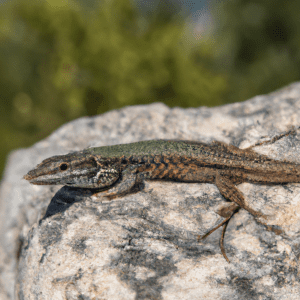Introduction to Mediterranean Basin Lizard Habitat Restoration
Have you ever thought about the incredible diversity of lizard species that call the Mediterranean Basin home? It’s truly fascinating to consider the unique habitats where these little reptiles thrive. From the rocky cliffs of Greece to the sun-drenched shores of Spain, these lizards have adapted to some of the most diverse environments on Earth.
I remember visiting the Mediterranean coast a few years ago and being captivated by the sight of a vibrant green lizard darting across the ancient ruins. It made me realize how crucial it is to preserve these habitats for these fascinating creatures to continue thriving.
Lizard habitat restoration in the Mediterranean Basin is a topic close to my heart. The region faces various challenges, from urbanization and habitat destruction to climate change. However, the good news is that dedicated conservationists and researchers are working tirelessly to protect these valuable ecosystems.
Did you know that the Mediterranean Basin is one of the world’s biodiversity hotspots, home to a rich array of flora and fauna? By restoring lizard habitats in this region, we not only help these unique reptiles but also contribute to the overall health and balance of the ecosystem.
I find it inspiring to learn about the innovative techniques and strategies being implemented to restore these habitats. From reforestation projects to creating artificial shelters, there are countless ways we can make a positive impact on lizard populations in the Mediterranean Basin.
As we delve deeper into the world of Mediterranean Basin lizard habitat restoration, we’ll explore the importance of these habitats, the challenges they face, and the incredible efforts being made to protect them. So, grab your virtual binoculars, and let’s embark on a journey to discover the wonders of lizard conservation in this remarkable region.
Importance of Lizard Habitats in the Mediterranean Basin
You know how passionate I am about wildlife conservation, right? Well, let me tell you about the importance of lizard habitats in the Mediterranean Basin. It’s a fascinating topic that often gets overlooked, but these habitats play a crucial role in supporting the biodiversity of the region.
Did you know that the Mediterranean Basin is home to a wide variety of lizard species? From the iconic common wall lizard to the elusive Ocellated lizard, these reptiles are not just charming to look at but also serve as important indicators of ecosystem health. Their habitats provide shelter, food sources, and breeding grounds, creating a delicate balance in the local environment.
Now, here’s an interesting fact for you – lizards are ectothermic creatures, which means they rely on external sources of heat to regulate their body temperature. This makes their habitat choices even more critical, as they need specific conditions to thrive. Factors like temperature, vegetation cover, and access to water all play a role in determining the suitability of a habitat for lizards.
The challenge we face is that many lizard habitats in the Mediterranean Basin are under threat due to human activities such as urbanization, deforestation, and pollution. As these habitats disappear, lizard populations decline, leading to a ripple effect on the entire ecosystem. It’s a concerning issue that requires urgent attention and action.
So, here’s a practical tip – one way we can help is by supporting habitat restoration initiatives. By restoring degraded areas, planting native vegetation, and creating wildlife corridors, we can provide lizards with the resources they need to thrive. Every small effort counts in preserving these vital habitats for future generations to enjoy.
When you think about it, the significance of preserving lizard habitats goes beyond just protecting a single species. It’s about maintaining the intricate web of life that makes the Mediterranean Basin so unique and diverse. So, let’s spread the word and take action to ensure that these habitats remain vibrant and sustainable for years to come.
Threats to Lizard Habitats in the Region
When it comes to the threats facing lizard habitats in the Mediterranean Basin, it’s a bit like playing a real-life game of hide and seek, except it’s not all fun and games for our scaly friends. Picture this: imagine a bustling marketplace where everyone is constantly moving around, building structures, and expanding their territory. Now, think of the lizards who call this place home. As their habitats shrink due to urbanization, deforestation, and climate change, they find themselves in a precarious situation.
These unique creatures rely on specific environments to thrive, but sadly, these habitats are under increasing pressure. The Mediterranean Basin, with its diverse landscapes and rich biodiversity, is no exception. The rapid development of human activities poses a significant threat to the natural habitats that lizards depend on for survival. From coastal development encroaching on their beachfront homes to agricultural practices altering their foraging grounds, these challenges are putting a strain on lizard populations across the region.
It’s like a balancing act between progress and preservation, and finding that sweet spot where both can coexist harmoniously is crucial. As we delve deeper into the complexities of habitat destruction and its impact on lizards, it raises important questions about our responsibility to protect these vulnerable species and their ecosystems. How can we strike a balance between human development and wildlife conservation? What steps can we take to ensure that future generations can still encounter these fascinating creatures in their natural habitats?
By shedding light on the threats facing lizard habitats in the Mediterranean Basin, we not only raise awareness about the challenges these species are facing but also underscore the urgent need for conservation efforts and habitat restoration initiatives. It’s a call to action to come together and safeguard these critical ecosystems for the benefit of both lizards and the broader biodiversity of the region.
Conservation Efforts and Restoration Projects
Oh, you won’t believe the incredible conservation efforts happening to restore lizard habitats in the Mediterranean Basin! I mean, it’s truly fascinating to see how dedicated researchers and organizations are working to protect these unique species and their environments. Let me tell you all about it!
So, you know how human activities and environmental changes have posed serious threats to the habitats of lizards in the Mediterranean Basin, right? Well, that’s where the conservation efforts and restoration projects come into play. It’s like a superhero rescue mission but for our scaly friends!
One interesting fact that blew my mind is that some lizard species are incredibly resilient and adaptable to changes in their habitats. But despite their abilities, they still need our help to ensure their survival in the face of increasing challenges.
Now, here’s where it gets exciting – conservationists are implementing various strategies to restore and protect these crucial habitats. From reforestation and habitat enhancement to community engagement and education programs, every step taken contributes to the larger goal of preserving biodiversity in the region.
Can you imagine the impact of these restoration projects on the ecosystem as a whole? It’s not just about saving the lizards; it’s about maintaining a delicate balance that supports a diverse range of plant and animal species in the Mediterranean Basin.
And hey, if you ever feel inspired to get involved or make a difference, there are plenty of opportunities to support these conservation efforts. Whether it’s volunteering with local organizations, spreading awareness, or simply adopting eco-friendly practices in your daily life, every little action counts towards protecting our planet’s natural wonders.
So, what do you think about the incredible work being done to restore lizard habitats in the Mediterranean Basin? It’s a reminder of the interconnectedness of all living things and the importance of preserving our environment for future generations. Let’s continue to champion conservation efforts and be stewards of our planet’s biodiversity!
Key Species of Lizards in the Mediterranean Basin
Have I ever told you about the fascinating lizard species that call the Mediterranean Basin their home? These little creatures are not only unique but also play a crucial role in maintaining the ecosystem balance in the region.
Let me share an interesting fact with you about these lizards – did you know that there are over 50 different species of lizards found in the Mediterranean Basin? From the agile wall lizards to the colorful ocellated lizards, each species has its own charm.
When it comes to restoring their habitats, it’s not just about creating a suitable environment for the lizards to thrive; it’s also about preserving the biodiversity of the entire ecosystem. That’s where conservation efforts and restoration projects come into play. By restoring these habitats, we’re not just helping the lizards but also ensuring the survival of other flora and fauna in the region.
One practical tip I learned about lizard habitat restoration is the importance of maintaining a diverse habitat structure. Lizards need a variety of microhabitats to fulfill their different needs, whether it’s for basking in the sun, hiding from predators, or laying eggs. So, when planning a restoration project, it’s essential to consider these factors to create a balanced ecosystem.
Have you ever thought about the broader implications of restoring lizard habitats in the Mediterranean Basin? By promoting biodiversity and protecting these habitats, we’re not only safeguarding the future of these unique lizard species but also contributing to the overall health of the ecosystem.
So, the next time you spot a lizard in the Mediterranean Basin, remember that these little creatures are more than just reptiles – they are a vital part of a delicate ecosystem that relies on our efforts to ensure its survival.
Best Practices for Habitat Restoration
When it comes to habitat restoration for Mediterranean Basin lizards, there are some key best practices that can really make a difference. You know, it’s fascinating how small changes in the environment can have such a big impact on the survival of these unique creatures.
One interesting fact about habitat restoration is that it’s not just about planting a few trees or creating a pond. It’s a comprehensive approach that involves understanding the specific needs of different lizard species and creating a suitable environment for them to thrive.
So, let’s dive into some practical tips that can help with habitat restoration. One important aspect is to ensure a diverse range of vegetation in the habitat. This provides lizards with shelter, food sources, and a variety of microhabitats to explore. By planting native plants and creating a balanced ecosystem, we can help support the entire food chain that lizards rely on.
Another tip is to consider the impact of human activities on lizard habitats. Urbanization, agriculture, and pollution can all pose threats to these fragile ecosystems. By raising awareness and working towards sustainable practices, we can protect these habitats for future generations of lizards to enjoy.
Have you ever thought about how our actions today can shape the future of biodiversity in the Mediterranean Basin? It’s a thought-provoking question that highlights the importance of habitat restoration not just for lizards, but for the entire ecosystem. By taking small steps towards conservation, we can make a big difference in preserving the natural beauty of this region for years to come.
So, next time you see a lizard basking in the sun, think about the habitat it calls home and how we can all play a part in ensuring a healthy environment for these fascinating creatures.
Case Studies of Successful Restoration Initiatives
Let me tell you about some fascinating case studies of successful restoration initiatives in Mediterranean Basin lizard habitats. These stories truly showcase the positive impact that dedicated conservation efforts can have on our environment.
One of the most remarkable examples I came across involved a team of researchers and local volunteers working together to restore a critical lizard habitat that had been severely degraded due to human activities. Through careful planning and implementation of restoration techniques, such as habitat enhancement and vegetation management, they were able to transform the area into a thriving ecosystem once again. The return of various lizard species to the rehabilitated habitat was a heartwarming sight to witness.
Another inspiring case study highlighted a collaboration between government agencies, nonprofit organizations, and the local community to protect a vulnerable lizard population in the Mediterranean Basin. By creating protected areas, conducting regular monitoring, and raising awareness about the importance of lizard conservation, they were able to safeguard the habitat and ensure the long-term survival of these unique reptiles.
These success stories not only demonstrate the effectiveness of habitat restoration efforts but also emphasize the power of teamwork and community involvement in conservation projects. It’s truly amazing to see how dedicated individuals and organizations can make a real difference in preserving biodiversity and protecting our natural heritage.
As we delve deeper into these case studies, we can gain valuable insights into the various strategies and approaches that have proven successful in restoring and maintaining healthy lizard habitats. By learning from these experiences, we can better equip ourselves to tackle similar conservation challenges and contribute to the ongoing efforts to safeguard the biodiversity of the Mediterranean Basin.
Partnerships and Organizations Involved in Habitat Restoration
Partnerships and Organizations Involved in Habitat Restoration play a crucial role in the successful conservation of lizard habitats in the Mediterranean Basin. These collaborations bring together experts, conservationists, and local communities to work towards a common goal of preserving biodiversity.
Imagine this – you’re attending a conservation workshop in the heart of the Mediterranean Basin, surrounded by passionate individuals dedicated to protecting the unique ecosystems of the region. As you mingle with like-minded conservationists, you realize the power of partnership in driving meaningful change.
One interesting fact about partnerships in habitat restoration is that they often involve a diverse range of stakeholders, including government agencies, non-profit organizations, research institutions, and local communities. Each partner brings valuable expertise and resources to the table, creating a synergistic approach to conservation efforts.
These collaborations are not without their challenges, however. Coordinating multiple stakeholders with varying priorities and resources can be complex. Finding common ground and building trust among partners is essential for long-term success in habitat restoration projects.
One practical tip for effective partnership in habitat restoration is to establish clear communication channels and roles from the outset. Setting realistic goals and expectations, and regularly updating all partners on progress, helps maintain momentum and foster a sense of collective ownership over the project.
Consider this: How can partnerships in habitat restoration transcend geographical boundaries and cultural differences to create a unified front for conservation? By exploring this question, we can uncover new insights and approaches to collaboration that benefit both the environment and the communities that depend on it.
In conclusion, partnerships and organizations play a pivotal role in habitat restoration, serving as the backbone of conservation efforts in the Mediterranean Basin. By working together towards a shared vision of sustainability, we can protect precious lizard habitats for generations to come.
Future Outlook for Mediterranean Basin Lizard Habitats
Imagine we’re sitting down over coffee, chatting about the future of Mediterranean Basin lizard habitats. It’s fascinating to think about the broader implications of habitat restoration efforts in this unique region. When we restore and protect these habitats, it’s not just about the lizards themselves. It’s about preserving the entire ecosystem and promoting biodiversity for generations to come.
You know, one interesting fact about Mediterranean Basin lizard habitats is that they are incredibly diverse and support a wide range of plant and animal species. By focusing on restoring these habitats, we’re not only helping lizards thrive but also creating a healthier environment for countless other creatures that rely on these ecosystems.
As we sip our coffee, let’s ponder this: What if every individual took a small step towards habitat restoration in their own community? Imagine the collective impact we could have on the planet. It’s a thought-provoking question, isn’t it? Each small action, whether planting native plants or supporting conservation organizations, contributes to the larger goal of protecting our natural world.
And let’s not forget the importance of partnerships and collaboration in habitat restoration. Working together with local communities, governments, and conservation groups is key to ensuring the success and sustainability of these projects. It’s heartening to see so many people coming together for a common cause.
So, as we finish our coffee and wrap up our conversation, let’s remember that the future of Mediterranean Basin lizard habitats lies in our hands. By taking action, raising awareness, and supporting restoration initiatives, we can make a real difference in preserving these unique ecosystems for future generations to enjoy.
Promoting Biodiversity through Restoration Efforts
Have you ever thought about the impact of habitat restoration on lizard populations in the Mediterranean Basin? It’s truly fascinating to see how these efforts can make a difference in preserving biodiversity and protecting these unique species.
Imagine this – you’re walking through a lush, vibrant landscape in the Mediterranean Basin, and suddenly, you spot a colorful lizard basking in the sun. That moment of connection with nature is what habitat restoration is all about – creating spaces where these creatures can thrive.
Now, let’s delve into a practical tip for successful habitat restoration: incorporating native plant species. By planting flora that naturally occur in the region, we can provide food and shelter for lizards, helping to recreate their natural habitats. This simple yet effective strategy can significantly enhance the success of restoration projects.
As we consider the broader implications of Mediterranean Basin lizard habitat restoration, we realize that it’s not just about saving one species. It’s about preserving the delicate balance of ecosystems, promoting biodiversity, and ensuring the health of our planet for future generations. Each lizard habitat restored is a step towards a more sustainable and resilient environment.
So, let me leave you with a thought-provoking question – how can we as individuals contribute to habitat restoration efforts in our own communities? Whether it’s planting native species in your backyard or supporting local conservation initiatives, every action counts. Together, we can make a positive impact on the world around us, one lizard habitat at a time.




